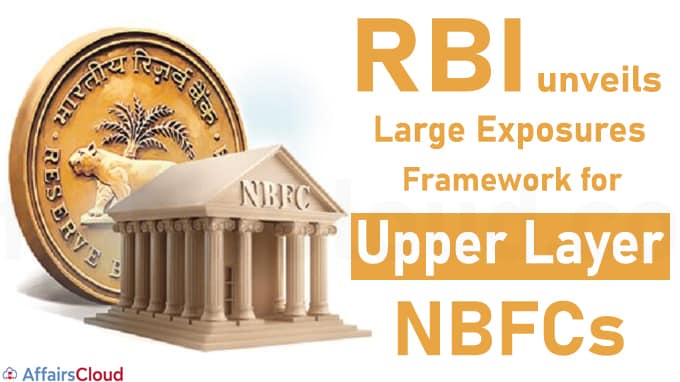
On April 19, 2022, the Reserve Bank of India (RBI) notified Large Exposures Framework (LEF) for Non-Banking Financial Company-Upper Layer (NBFC-UL) w.e.f. October 1, 2022. These exposure limits are in lines with the commercial banks.
What is NBFC-UL?
NBFC-UL comprises those NBFCs which are specifically identified by RBI as warranting enhanced regulatory requirements. The top ten eligible NBFCs in terms of their asset size will always fall in the upper layer, irrespective of any other factor.
What is Large Exposure (LE)?
It is the sum of all exposure values of a NBFC-UL to counterparty and/or a group of connected counterparties, if it is equal to or above 10% of the NBFC-UL’s eligible capital base.
LEF for NBFC as mandated by RBI:
For Single Counterparty:
The sum of all the exposure values of a NBFC-UL must not be higher than 20% of its available eligible capital base at all times. The limit can only be extended by another 5% with board’s approval.
- An Infrastructure Finance Company (IFC) which is classified as an NBFC-UL can exceed the aforementioned limits by 5% of its Tier-I capital.
- An NBFC-UL may exceed the exposure limit by 5% of its Tier I capital, if the additional exposure is on account of infrastructure loan and/ or investment.
For Group of Connected Counterparties:
The sum of all the exposure values of a NBFC-UL must not be higher than 25% of its available eligible capital base at all times.
- An IFC which is classified as an NBFC-UL can exceed the aforementioned limits by 10% of its Tier-I capital.
- An NBFC-UL may exceed the exposure limit by 10% of its Tier-I capital, if the additional exposure is on account of infrastructure loan and/ or investment.
Tabular Format of LEF:
| Category | NBFC-UL (Other than IFC) | NBFC-UL (IFC) |
|---|---|---|
| Single Counterparty | •20% •Additional 5% with Board approval • Additional 5% if exposure towards Infrastructure loan/investment | •25% •additional 5% with Board approval |
| Group of Connected Counterparties | •25% • Additional 10% if exposure towards Infrastructure loan/investment | • 35% |
Point to be Noted: Single counterparty limit will not exceed 25% in any case for NBFC-UL (other than IFC), and 30% for NBFC-UL (IFC). For Group of Connected Counterparties limit will not exceed 25% in any case for NBFC-UL (other than IFC), and 35% for NBFC-UL (IFC).
The breach of the above limits may lead to imposition of penalties on the NBFCs.
Click Here for Official LEF for NBFC-UL
RBI mandates NBFCs-UL to maintain CET1 Capital of at least 9% of Risk Weighted Assets
RBI mandates NBFC-UL to maintain Common Equity Tier 1 (CET1) capital of at least 9% of Risk Weighted Assets as compared to 5.5% for banks. This will be applicable to all NBFC-UL except core investment companies (CICs).
- CET1 ratio= Common Equity Tier 1 capital/Total Risk Weighted Assets
Key Points:
i.Common Equity Tier 1 capital will comprise of paid-up equity share capital issued by the NBFC, share premium resulting from the issue of equity shares, capital reserves representing surplus arising out of sale proceeds of assets, Statutory reserves, Revaluation reserves, and other disclosed free reserves, among others.
ii.The minimum capital adequacy requirement of NBFCs is 15%.
Click here for official Scale Based Regulation (SBR) for NBFCs: Capital requirements for NBFC-UL
Points to be noted:
i.NBFCs middle layer (ML) and NBFC-UL will not grant loans of Rs 5 crore and above to their directors or relatives of directors. Loan proposals for under Rs 5 crore to directors is allowed to be sanctioned, but should be reported to the NBFC’s board.
ii.RBI has also introduced a following path for a minimum number of days before an account is recognized as a Non-Performing Asset (NPA). This is applicable for all NBFCs, listed and unlisted.
- NBFCs must move to a 150-day NPA recognition norm by March 31, 2024
- NPA recognition at 120 days of overdue must be achieved by March 31, 2025
- NBFCs must follow 90-day NPA recognition cycle by March 31, 2026.
Recent Related News:
i.Recently, RBI mandates all NBFC-UL and Middle Layer (NBFC-ML) to have independent Compliance Function by April 1, 2023, and to appoint of Chief Compliance Officer (CCO) by October 1, 2023.
ii.The Government of India (GOI) has done a conversion switch transaction of its securities with RBI on January 28, 2022 for an amount of Rs. 1,19,701 crore (face value). The GOI undertakes switch operations with RBI and also with market participants to smoothen the liability profile as well as for market development.
About Reserve Bank of India (RBI):
Establishment– April 1, 1935
Headquarters– Mumbai, Maharashtra
Governor– Shaktikanta Das
Deputy Governors– Mahesh Kumar Jain, Michael Debabrata Patra, M. Rajeshwar Rao, T. Rabi Sankar




